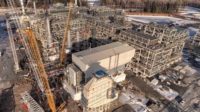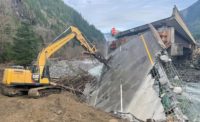Presidential Campaign
Infrastructure Investment Plans Draw Construction's Attention

Squaring Off GOP nominee Trump wants to use a bond fund for his proposed infrastructure funding program; Clinton’s plan includes an infrastructure bank and the return of the 2009-2010 Build America Bonds program. Photos courtesy of AP Photo
As the presidential candidates step up their campaigns, they are talking up ambitious proposals to boost funding for transportation and other infrastructure investments. Construction-industry officials welcome the focus on public works but say the plans aren’t fleshed out and face hurdles in the next Congress.
The Democratic nominee, former Secretary of State Hillary Clinton, has been pushing a $275-billion, five-year infusion for transportation, water, energy and other projects, including the launch of a federal infrastructure bank. Clinton has promised that, if elected, she will send Congress legislation within her first 100 days in office to carry out the proposal.
The Republican nominee, businessman Donald Trump, said little about infrastructure during his party’s July convention. But on Aug. 2 he floated an even larger public-works idea: a bond fund that, he said, would be “at least double” what Clinton envisions. He provided few specifics.
Jay Hansen, National Asphalt Pavement Association executive vice president, says, “On the upside, both candidates and party platforms do talk about the need to invest in our infrastructure.” But he says there are questions about both plans: “What can be passed in the next Congress? How are they going to pay for it—is it through tax reform? Are they just going to do another stimulus bill?”
Brian Turmail, spokesman for the Associated General Contractors of America, said via email: “Mr. Trump clearly understands the economic wisdom of investing in infrastructure in that it will both help create high-paying jobs in the short term and position the country for broader economic growth over the long term.” Turmail added, “But like many others, we are very anxious to see details of how he plans to pay for and administer his latest infrastructure proposal.”
Andrew Goldberg, managing director of government relations for the American Institute of Architects, noted to 800 AEC sector marketing professionals in Philadelphia on Aug. 11 that Trump's "own advisers hate it," but he did not elaborate.
Goldberg noted the need for more attention and funding for "vertical infrastructure," public buildings such as courthouses and schools. He said AIA will sponsor a conference in New York City after the election on approaches to boost capital investment in that type of infrastructure.
But Goldberg added that under the Democrats' tax plan, many AEC firms would not gain lower rates because of their corporate structures.
Trump Sees New Generation
Trump said in a speech in Detroit on Aug. 8 that a proposed reduction in tax rates and other actions would create “new wealth,” some of which could go toward rebuilding infrastructure. “We will build the next generation of roads, bridges, railways, tunnels, seaports and airports,” he declared.
Terry O’Sullivan, general president of the Laborers’ International Union of North America—and a Clinton supporter—criticized Trump’s proposal as “closer to incoherent rambling than a serious policy proposal, and it contrasts sharply with the thoughtful and reasoned plan Secretary Clinton has mapped out.”
Her proposal includes $250 billion in direct spending and $25 billion for an infrastructure bank. The bank’s start-up capital could support as much as $225 billion in loans or other aid, the Clinton campaign says. LIUNA’s O’Sullivan thinks the leverage could be stronger, generating $500 billion in loans. To finance the infrastructure spending surge, Clinton would use “business tax reform,” according to her campaign’s summary of the plan.
The proposal also would bring back and expand the Build America Bonds program, established in 2009. That program was popular among states and localities, which issued $181 billion of the taxable, federally subsidized bonds. But it expired at the end of 2010.
Neither infrastructure proposal, however, will coast through Capitol Hill, given the likely shape of the next Congress. Republicans are expected to keep control of the House, though perhaps with a narrower margin than they now hold. The Senate majority could go either way, but whichever party wins control there in November probably won’t have the 60 votes needed to clear procedural roadblocks and move legislation.
"It will come down to voter turnout," John Bryant, senior federal affairs director for NAIOP, the commercial real estate trade group, told the AEC marketing professionals.
Democrats Want 'Clean' Energy
The parties’ platforms show big differences on other construction-related issues. In energy, the Democrats endorse getting 50% of electric power from “clean energy sources” in 10 years and eliminating tax breaks for fossil-fuel-producing companies.
The GOP blueprint, on the other hand, is more favorable for oil, gas and coal. It calls for finishing the Keystone pipeline and opening public lands and the outer continental shelf to oil and gas exploration. It also supports “cost-effective” private development of wind, solar and other renewable power sources.
The parties also are far apart on environmental issues. The Democrats’ document promises “bold steps to slash carbon pollution” and to “lead the fight against climate change around the world.”
The GOP platform seeks to turn the US Environmental Protection Agency into an “independent bipartisan commission,” like the Nuclear Regulatory Commission, and do away with the EPA’s Clean Power air-pollution regulation. It also calls an EPA-Corps of Engineers rule to define federally regulated waters a “travesty.”
Trump, in his speech in Detroit, said he would institute a temporary moratorium on new federal rules and added, “I am going to cut regulations massively.” He said coal-fired power plants in Michigan have shut down or undergone “expensive conversions” as a result of EPA rules.
But AIA's Goldberg predicted that states could take up the slack in pushing new U.S. energy policy. He said the Obama Clean Power program. "allows states to develop their own energy plans. Alot of legislative policy will be set at the state level, with major opportunities for AEC firms."
Related to workforce issues, the Democrats’ document has items that organized labor likes, including a provision to direct the National Labor Relations Board to certify a union if a majority of workers sign authorization cards.
The GOP’s platform criticizes the Labor Dept. and the NLRB, saying they “have scrapped decades of labor law to implement the agenda of big labor.” It also seeks to repeal the Davis-Bacon Act, which mandates prevailing wages, often union scale, on federally funded projects.
AIA's Goldberg expects Trump to rescind Obama proposed rules that mandate higher wage threshholds for paying overtime, that are to take effect on Dec. 1. He said if they go forward under a Clinton administration, the impact on AEC firms is "unclear," although Congress could also move to halt implementation.
Goldberg said that while younger employees favor the overtime pay hike, it could "restrict the kind of work that newer employees do, and could have a big impact on an architecture firm's "culture." Employers might need to boost pay for employees to avoid the overtime floor.
In transportation, the Republicans’ platform recommends phasing out federal funding for transit, saying public transportation is “an inherently local affair that serves only a small portion of the population.” Further, it opposes increasing the federal gasoline tax, which has stood at 18.4¢ per gallon since 1993.
The American Public Transportation Association strongly opposes the GOP phase-out idea. APTA Acting President and CEO Richard White said in a July 19 statement, “Having no federal funds would be devastating” to riders, employers and local communities. APTA notes that federal funds accounted for more than 40% of total transit capital spending in 2013.
Republicans Advocate Alternative Funding
The Republican platform also says federal funding for some other non-highway programs should wind down, including recreational trails, sidewalks and access to federal lands. It does add that non-highway projects are “worthwhile enterprises” that “should be funded from other sources,” but it doesn’t specify the sources.
Hansen notes that neither candidate and platform addresses a central issue for firms that concentrate on transportation projects: how to deal with the “structural deficit” in the Highway Trust Fund.
Election Day is still weeks away, but Steve Hall, American Council of Engineering Companies vice president for government affairs, says, “I think this presidential contest is far more political and polarizing than any in modern history.”
Whoever wins in November needs “an agenda for 2017 that might heal that divide,” says Hall. “Infrastructure would be the perfect way to do that. It traditionally brings together business and labor, Republicans and Democrats.”
But NAIOP's John Bryant told the marketing professionals in Philadelphia that Clinton would be "the next president. Trump is self-destructing."






